Evaluation of SWIR Crop Residue Bands for the Landsat Next Mission
Abstract
:1. Introduction
1.1. Spectral Characteristics of the Agricultural Land Surface
1.2. Crop Residue Measurement Using Broadband Multispectral Indices
1.3. Narrowband SWIR Indices Measuring 2100 nm and 2300 nm Ligno-Cellulose Absorption Features
1.4. Future of Landsat
2. Materials and Methods
2.1. Hyperspectral Source Data
2.2. Selection of Shortwave Infrared (SWIR) Bands and Indices
2.3. Assessment of Atmospheric Interference
2.4. Assessment of Signal to Noise Ratio
2.5. Accuracy of NPV Measurement
2.6. Effects of Background Soil Spectra
2.7. Assessment of Mission Continuity
3. Results and Discussion
3.1. Effects of Atmosphere and Bandwidth on SWIR Band Reflectance
3.2. MODTRAN Assessment of Atmospheric Impacts on Band Radiometric Performance
3.3. Sensor Signal-to-Noise Ratio Uncertainty Analysis
3.4. Measurement of NPV
3.5. Effect of Varying Background Soil Reflectance
3.6. Mission Continuity
4. Summary of Findings
5. Spectral Bands to Consider for the Landsat Next Mission
- (1)
- Three bands at 2040, 2100, and 2210 nm (CAI index): Use of the CAI index is a well-established technique for determining the depth of the 2100 nm ligno-cellulose absorption feature and it performed well for samples with minimal green vegetation (NDVI < 0.3; R2 = 0.77). It was also the index most resistant to impacts from green vegetation (NDVI < 1.0; R2 = 0.71). However, the 2040 nm band center is positioned between two strong atmospheric absorption features associated with CO2 and water vapor, and therefore requires use of a narrow bandwidth (likely < = 20 nm for best results) as well as an accurate atmospheric correction since conversion from surface reflectance to at-sensor radiance had a strong impact on index values. A 30–50 nm bandwidth is likely adequate for the 2100 and 2210 nm bands.
- (2)
- Two bands at 2210 and 2260 nm (SINDRI, SIRRI, and SIDRI indices): The SINDRI index was the top performer in predicting agricultural NPV cover under non-vegetated conditions (NDVI <0.3; R2 = 0.81, boxcar spectra) and was also quite resistant to atmospheric interference. Its performance was greatly reduced in the presence of higher levels of green vegetation (NDVI < 1.0; R2 = 0.40). However, the SIDRI simple difference index appears to avoid the interference from green vegetation, maintaining a performance (NDVI < 1.0; R2 = 0.71) that was similar to CAI. Good results can likely be achieved at 30–50 nm bandwidth for these two bands.
- (3)
- Three bands at 2100, 2210, and 2260 nm (SINDRI, SIRRI, and SIDRI indices, as well as LCPCDI). While determination of NPV would focus on the SINDRI and SIDRI indices (2210 and 2260 nm), this three-band solution provides the greatest degree of mission continuity (convolved three-band reflectance was very similar to the current OLI Band 7) as well as the capability to employ the 2100 nm band in calculating spectral angle indices that could adjust for the presence of soil spectral absorption features in this range. Good results can likely be achieved by using a 30–50 nm bandwidth for each of the three bands.
- (4)
- Four bands at 2040, 2100, 2210, and 2260 nm (all of the above listed indices): This robust solution would support the calculation of SINDRI for conditions with minimal vegetation, and CAI for conditions with moderate vegetation, each being the best-performing index for those vegetation classes. Additionally, the abundance of bands would provide useful information to calibrate results to account for soil moisture content and mineral absorption features.
Author Contributions
Funding
Institutional Review Board Statement
Informed Consent Statement
Data Availability Statement
Conflicts of Interest
Disclaimer
Abbreviations
| CAI | Cellulose absorption index |
| GV | Green vegetation |
| LCA | Lignin-cellulose absorption index |
| LCPCDI | Lignin-cellulose peak centered difference index |
| NDTI | Normalized difference tillage index |
| NDVI | Normalized difference vegetation index |
| SIDRI | Shortwave infrared difference residue index |
| SINDRI | Shortwave infrared normalized difference residue index |
| SIRRI | Shortwave infrared ratio residue index |
| SWIR | Shortwave infrared wavelengths |
References
- Lal, R.; Bruce, J.P. The potential of world cropland soils to sequester C and mitigate the greenhouse effect. Environ. Sci. Policy 1999, 2, 177–185. [Google Scholar] [CrossRef]
- Magdoff, F. Soil Organic Matter Management Strategies. In Soil Organic Matter in Sustainable Agriculture; CRC Press: Boca Raton, FL, USA, 2004. [Google Scholar]
- Palm, C.; Blanco-Canqui, H.; DeClerck, F.; Gatere, L.; Grace, P. Conservation agriculture and ecosystem services: An overview. Agric. Ecosyst. Environ. 2014, 187, 87–105. [Google Scholar] [CrossRef] [Green Version]
- Beeson, P.C.; Daughtry, C.S.T.; Wallander, S.A. Estimates of conservation tillage practices using landsat archive. Remote Sens. 2020, 12, 2665. [Google Scholar] [CrossRef]
- CTIC (Conservation Technology Information Center). Procedures for Using the Cropland Roadside Transect Survey for Obtaining Tillage Crop Residue Data; Conservation Technology Information Center, Purdue University: West Lafayette, IN, USA, 2009; Available online: http://www.ctic.org (accessed on 2 June 2021).
- Bonham, C.D. Measurements for Terrestrial Vegetation; John Wiley & Sons: New York, NY, USA, 1989; ISBN 0471048801. [Google Scholar]
- Morrison, J.E.; Huang, C.; Lightle, D.T.; Daughtry, C.S.T. Residue Cover Measurement Techniques. J. Soil Water Conserv. 1993, 48, 478–483. [Google Scholar]
- Booth, D.T.; Cox, S.E.; Berryman, R.D. Point sampling digital imagery with “Samplepoint”. Environ. Monit. Assess. 2006, 123, 97–108. [Google Scholar] [CrossRef] [PubMed]
- Daughtry, C.S.T.; Hunt, E.R., Jr.; Doraiswamy, P.C.; McMurtrey, J.E. Remote sensing the spatial distribution of crop residues. Agron. J. 2005, 97, 864–871. [Google Scholar] [CrossRef]
- Serbin, G.; Hunt, E.R., Jr.; Daughtry, C.S.T.; McCarty, G.W.; Doraiswamy, P.C. An improved ASTER index for remote sensing of crop residue. Remote Sens. 2009, 1, 971–991. [Google Scholar] [CrossRef] [Green Version]
- Hively, W.D.; Lamb, B.T.; Daughtry, C.S.T.; Shermeyer, J.; McCarty, G.W.; Quemada, M. Mapping crop residue and tillage intensity using WorldView-3 satellite shortwave infrared residue indices. Remote Sens. 2018, 10, 1657. [Google Scholar] [CrossRef] [Green Version]
- Tucker, C.J. Red and photographic infrared linear combinations monitoring vegetation. Remote Sens. Environ. 1979, 8, 127–150. [Google Scholar] [CrossRef] [Green Version]
- Prabhakara, K.; Dean Hively, W.; McCarty, G.W. Evaluating the relationship between biomass, percent groundcover and remote sensing indices across six winter cover crop fields in Maryland, United States. Int. J. Appl. Earth Obs. Geoinf. 2015, 39, 88–102. [Google Scholar] [CrossRef] [Green Version]
- Serbin, G.; Daughtry, C.S.T.; Hunt, E.R., Jr.; Brown, D.J.; McCarty, G.W. Effect of Soil Spectral Properties on Remote Sensing of Crop Residue Cover. Soil Sci. Soc. Am. J. 2009, 73, 1545. [Google Scholar] [CrossRef]
- Daughtry, C.S.T.; Serbin, G.; Reeves, J.B.; Doraiswamy, P.C.; Hunt, E.R., Jr. Spectral reflectance of wheat residue during decomposition and remotely sensed estimates of residue cover. Remote Sens. 2010, 2, 416–431. [Google Scholar] [CrossRef] [Green Version]
- Daughtry, C.S.T.; Hunt, E.R., Jr. Mitigating the effects of soil and residue water contents on remotely sensed estimates of crop residue cover. Remote Sens. Environ. 2008, 112, 1647–1657. [Google Scholar] [CrossRef]
- Elvidge, C.D. Visible and near infrared reflectance characteristics of dry plant materials. Int. J. Remote Sens. 1990, 11, 1775–1795. [Google Scholar] [CrossRef]
- Daughtry, C.S.T. Agroclimatology: Discriminating crop residues from soil by shortwave infrared reflectance. Agron. J. 2001, 93, 125–131. [Google Scholar] [CrossRef]
- Kokaly, R.; Asner, G.P.; Ollinger, S.V.; Martin, M.E.; Wessman, C.A. Characterizing canopy biochemistry from imaging spectroscopy and its application to ecosystem studies. Remote Sens. Environ. 2009, 113, 78–91. [Google Scholar] [CrossRef]
- Nagler, P.L.; Daughtry, C.S.T.; Goward, S.N. Plant litter and soil reflectance. Remote Sens. Environ. 2000, 71, 207–215. [Google Scholar] [CrossRef]
- Beeson, P.C.; Daughtry, C.S.T.; Hunt, E.R., Jr.; Akhmedov, B.; Sadeghi, A.M.; Karlen, D.L.; Tomer, M.D. Multispectral satellite mapping of crop residue cover and tillage intensity in Iowa. J. Soil Water Conserv. 2016, 71, 385–395. [Google Scholar] [CrossRef] [Green Version]
- Jin, X.; Ma, J.; Wen, Z.; Song, K. Estimation of maize residue cover using Landsat-8 OLI image spectral information and textural features. Remote Sens. 2015, 7, 14559–14575. [Google Scholar] [CrossRef] [Green Version]
- Najafi, P.; Navid, H.; Feizizadeh, B.; Eskandari, I.; Blaschke, T. Fuzzy object-based image analysis methods using Sentinel-2A and Landsat-8 data to map and characterize soil surface residue. Remote Sens. 2019, 11, 2583. [Google Scholar] [CrossRef] [Green Version]
- Thoma, D.P.; Gupta, S.C.; Bauer, M.E. Evaluation of optical remote sensing models for crop residue cover assessment. J. Soil Water Conserv. 2004, 59, 224–233. [Google Scholar]
- Van Deventer, A.P.; Ward, A.D.; Gowda, P.M.; Lyon, J.G. Using thematic mapper data to identify contrasting soil plains and tillage practices. Photogramm. Eng. Remote Sensing. 1997, 63, 87–93. [Google Scholar]
- Zheng, B.; Campbell, J.B.; Serbin, G.; Galbraith, J.M. Remote sensing of crop residue and tillage practices: Present capabilities and future prospects. Soil Tillage Res. 2014, 138, 26–34. [Google Scholar] [CrossRef]
- Gelder, B.K.; Kaleita, A.L.; Cruse, R.M. Estimating mean field residue cover on midwestern soils using satellite imagery. Agron. J. 2009, 101, 635–643. [Google Scholar] [CrossRef]
- Hively, W.D.; Shermeyer, J.; Lamb, B.T.; Daughtry, C.T.; Quemada, M.; Keppler, J. Mapping crop residue by combining landsat and worldview-3 satellite imagery. Remote Sens. 2019, 11, 1857. [Google Scholar] [CrossRef] [Green Version]
- Laamrani, A.; Joosse, P.; McNairn, H.; Berg, A.A.; Hagerman, J.; Powell, K.; Berry, M. Assessing soil cover levels during the non-growing season using multitemporal satellite imagery and spectral unmixing techniques. Remote Sens. 2020, 12, 1397. [Google Scholar] [CrossRef]
- Ding, Y.; Zhang, H.; Wang, Z.; Xie, Q.; Wang, Y.; Liu, L.; Hall, C.C. A Comparison of Estimating Crop Residue Cover from Sentinel-2 Data Using Empirical Regressions and Machine Learning Methods. Remote Sens. 2020, 12, 1470. [Google Scholar] [CrossRef]
- Yue, J.; Tian, Q.; Dong, X.; Xu, K.; Zhou, C. Using hyperspectral crop residue angle index to estimate maize and winter-wheat residue cover: A laboratory study. Remote Sens. 2019, 11, 807. [Google Scholar] [CrossRef] [Green Version]
- Quemada, M.; Daughtry, C.S.T. Spectral indices to improve crop residue cover estimation under varying moisture conditions. Remote Sens. 2016, 8, 660. [Google Scholar] [CrossRef] [Green Version]
- Quemada, M.; Hively, W.D.; Daughtry, C.S.T.; Lamb, B.T.; Shermeyer, J. Improved crop residue cover estimates obtained by coupling spectral indices for residue and moisture. Remote Sens. Environ. 2018, 206, 33–44. [Google Scholar] [CrossRef]
- Eskandari, I.; Navid, H.; Rangzan, K. Evaluating spectral indices for determining conservation and conventional tillage systems in a vetch-wheat rotation. Int. Soil Water Conserv. Res. 2016, 4, 93–98. [Google Scholar] [CrossRef] [Green Version]
- Serbin, G.; Hunt, E.R., Jr.; Daughtry, C.S.T.; McCarty, G.W. Assessment of spectral indices for cover estimation of senescent vegetation. Remote Sens. Lett. 2013, 4, 552–560. [Google Scholar] [CrossRef]
- Serbin, G.; Daughtry, C.S.T.; Hunt, E.R., Jr.; Reeves, J.B.; Brown, D.J. Effects of soil composition and mineralogy on remote sensing of crop residue cover. Remote Sens. Environ. 2009, 113, 224–238. [Google Scholar] [CrossRef]
- Transon, J.; d’Andrimont, R.; Maugnard, A.; Defourny, P. Survey of hyperspectral Earth Observation applications from space in the Sentinel-2 context. Remote Sens. 2018, 10, 157. [Google Scholar] [CrossRef] [Green Version]
- Bannari, A.; Staenz, K.; Champagne, C.; Khurshid, K.S. Spatial variability mapping of crop residue using hyperion (EO-1) hyperspectral data. Remote Sens. 2015, 7, 8107–8127. [Google Scholar] [CrossRef] [Green Version]
- Pepe, M.; Pompilio, L.; Gioli, B.; Busetto, L.; Boschetti, M. Detection and Classification of Non-Photosynthetic Vegetation from PRISMA Hyperspectral Data in Croplands. Remote Sens. 2020, 12, 3903. [Google Scholar] [CrossRef]
- Cawse-Nicholson, K.; Townsend, P.A.; Schimel, D.; Assiri, A.M.; Blake, P.L.; Buongiorno, M.F.; Campbell, P.; Carmon, N.; Casey, K.A.; Correa-Pabón, R.E.; et al. NASA’s surface biology and geology designated observable: A perspective on surface imaging algorithms. Remote Sens. Environ. 2021, 257, 112349. [Google Scholar] [CrossRef]
- NGAC. Recommendations for Possible Future U.S. Global Land Data Collection Missions Beyond Landsat 9: A Report of the National Geospatial Advisory Committee Landsat Advisory Group, April 2018. Available online: https://www.fgdc.gov/ngac/meetings/april-2018/ngac-landsat-future-missions-recommendations-paper.pdf (accessed on 2 June 2021).
- Wu, Z.; Snyder, G.; Vadnais, C.; Arora, R.; Babcock, M.; Stensaas, G.; Doucette, P.; Newman, T. User needs for future Landsat missions. Remote Sens. Environ. 2019, 231, 111214. [Google Scholar] [CrossRef]
- Dennison, P.E.; Qi, Y.; Meerdink, S.K.; Kokaly, R.F.; Thompson, D.R.; Daughtry, C.S.T.; Quemada, M.; Roberts, D.A.; Gader, P.D.; Wetherley, E.B.; et al. Comparison of methods for modeling fractional cover using simulated satellite hyperspectral imager spectra. Remote Sens. 2019, 11, 2072. [Google Scholar] [CrossRef]
- Hively, W.D.; Lamb, B.T.; Daughtry, C.S.T.; Serbin, G.; Dennison, P. Reflectance Spectra of Agricultural Field Conditions Supporting Remote Sensing Evaluation of Non-Photosynthetic Vegetative Cover. 2021. (U.S. Geological Survey Data Release. Available online: https://doi.org/10.5066/P9XK3867 (accessed on 14 September 2021). [CrossRef]
- ASD Incorporated/Malvern Panalytical, Westborough, MA, USA. Available online: www.malvernpanalytical.com (accessed on 2 June 2021).
- Spectralon; Labsphere, Inc.: North Sutton, NH, USA, 1994.
- Thompson, D.R.; Gao, B.C.; Green, R.O.; Roberts, D.A.; Dennison, P.E.; Lundeen, S.R. Atmospheric correction for global mapping spectroscopy: ATREM advances for the HyspIRI preparatory campaign. Remote Sens. Environ. 2015, 167, 64–77. [Google Scholar] [CrossRef]
- Berk, A.; Conforti, P.; Kennett, R.; Perkins, T.; Hawes, F.; Van Den Bosch, J. MODTRAN® 6: A major upgrade of the MODTRAN® radiative transfer code. In Proceedings of the 2014 6th Workshop on Hyperspectral Image and Signal Processing: Evolution in Remote Sensing (WHISPERS), Lausanne, Switzerland, 24–27 June 2014; IEEE: Piscataway, NJ, USA; pp. 1–4. [Google Scholar]
- Brown, D.J.; Shepherd, K.D.; Walsh, M.G.; Dewayne Mays, M.; Reinsch, T.G. Global soil characterization with VNIR diffuse reflectance spectroscopy. Geoderma 2006, 132, 273–290. [Google Scholar] [CrossRef]
- Kokaly, R.F.; King, T.V.V.; Hoefen, T.M. Surface Mineral Maps of Afghanistan Derived from HyMap Imaging Spectrometer Data, Version 2: U.S. Geological Survey Data Series 787, 29p, 2013. Available online: https://pubs.usgs.gov/ds/787/ (accessed on 6 August 2021).
- Graham, G.E.; Kokaly, R.F.; Kelley, K.D.; Hoefen, T.M.; Johnson, M.R.; Hubbard, B.E. Application of imaging spectroscopy for mineral exploration in Alaska: A study over porphyry Cu deposits in the eastern Alaska Range. Econ. Geol. 2018, 113, 489–510. [Google Scholar] [CrossRef]
- The ASTER Mineral Map of Australia, Cudahy et al., Auscope Discovery Portal. Available online: http://portal.auscope.org.au/ (accessed on 6 August 2021).
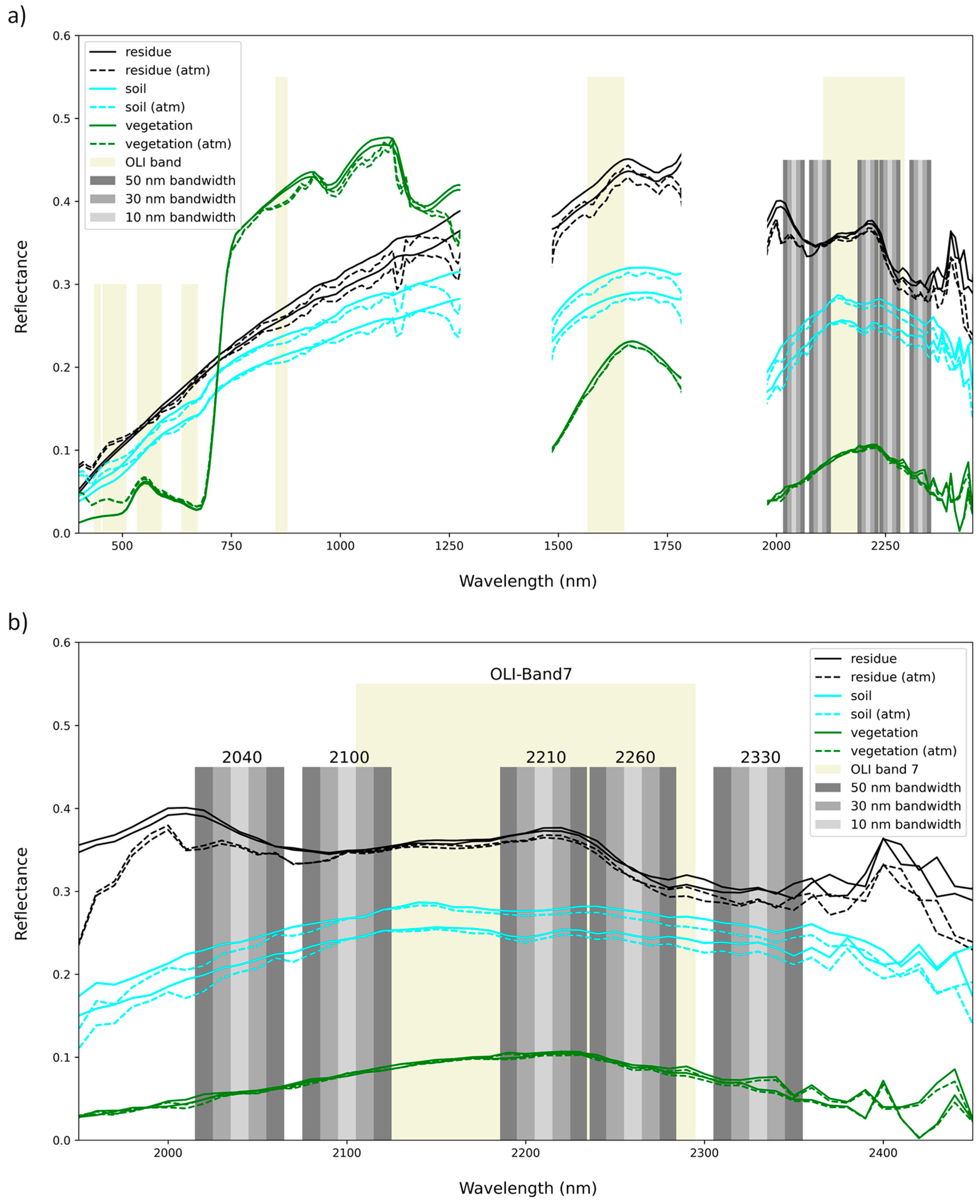

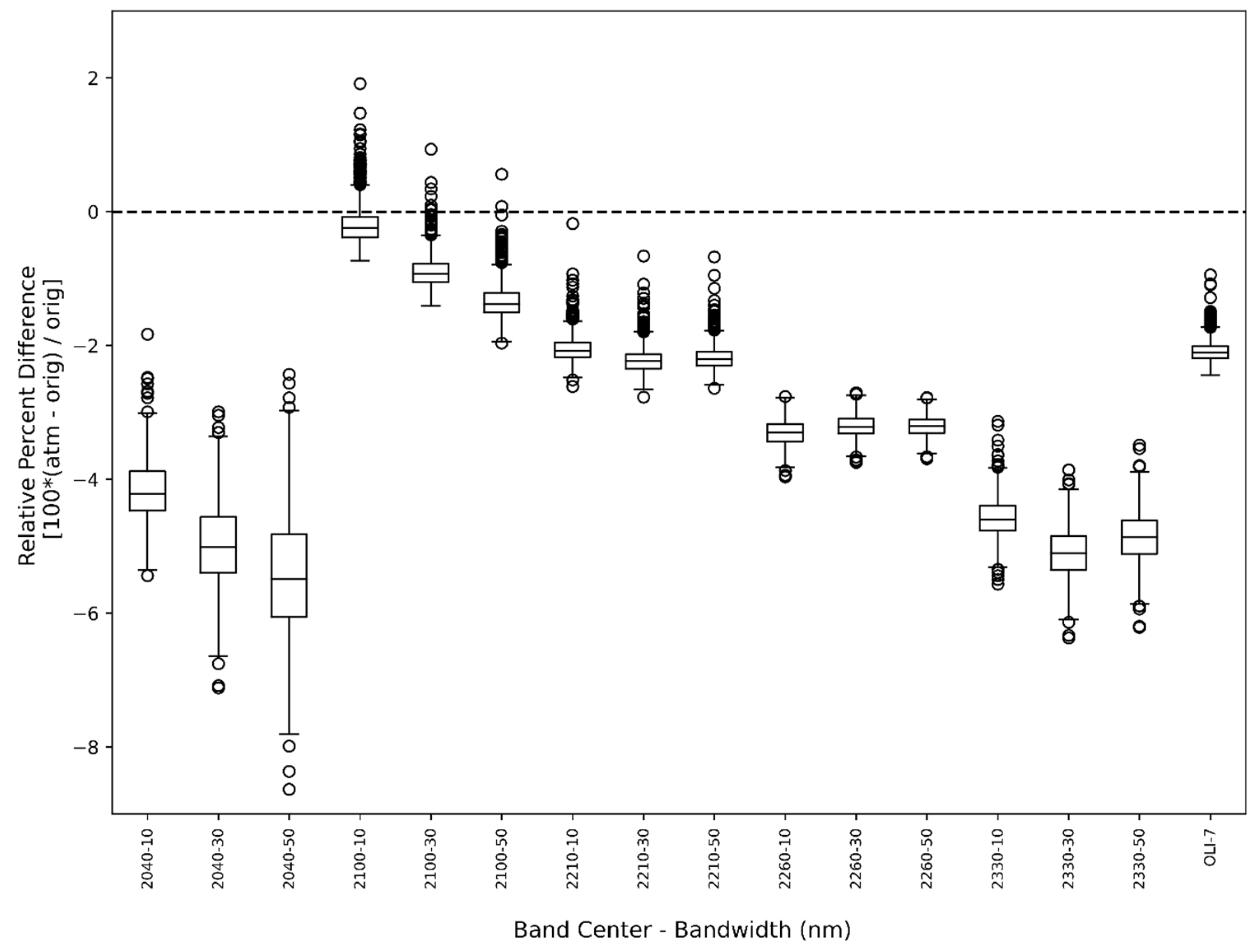
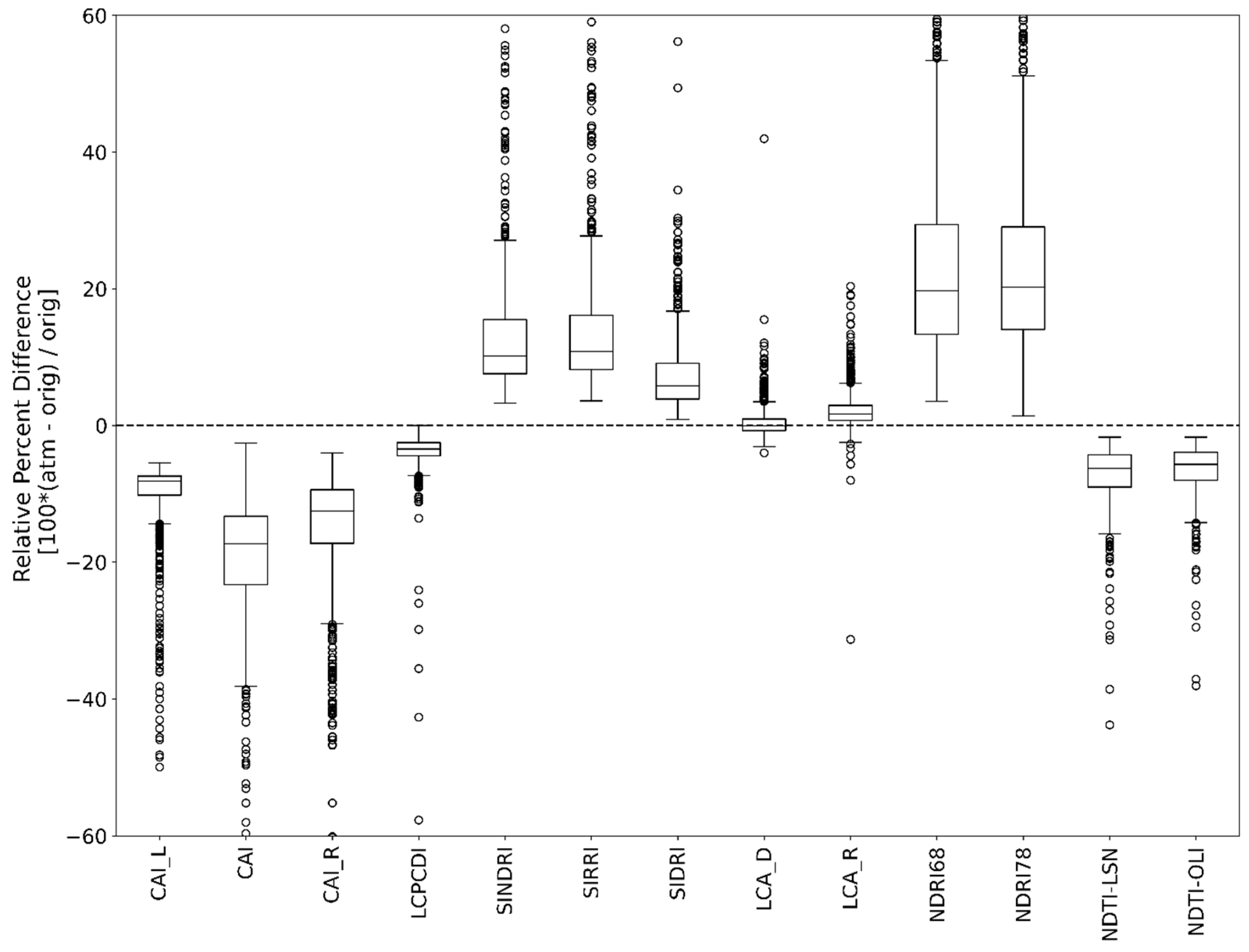
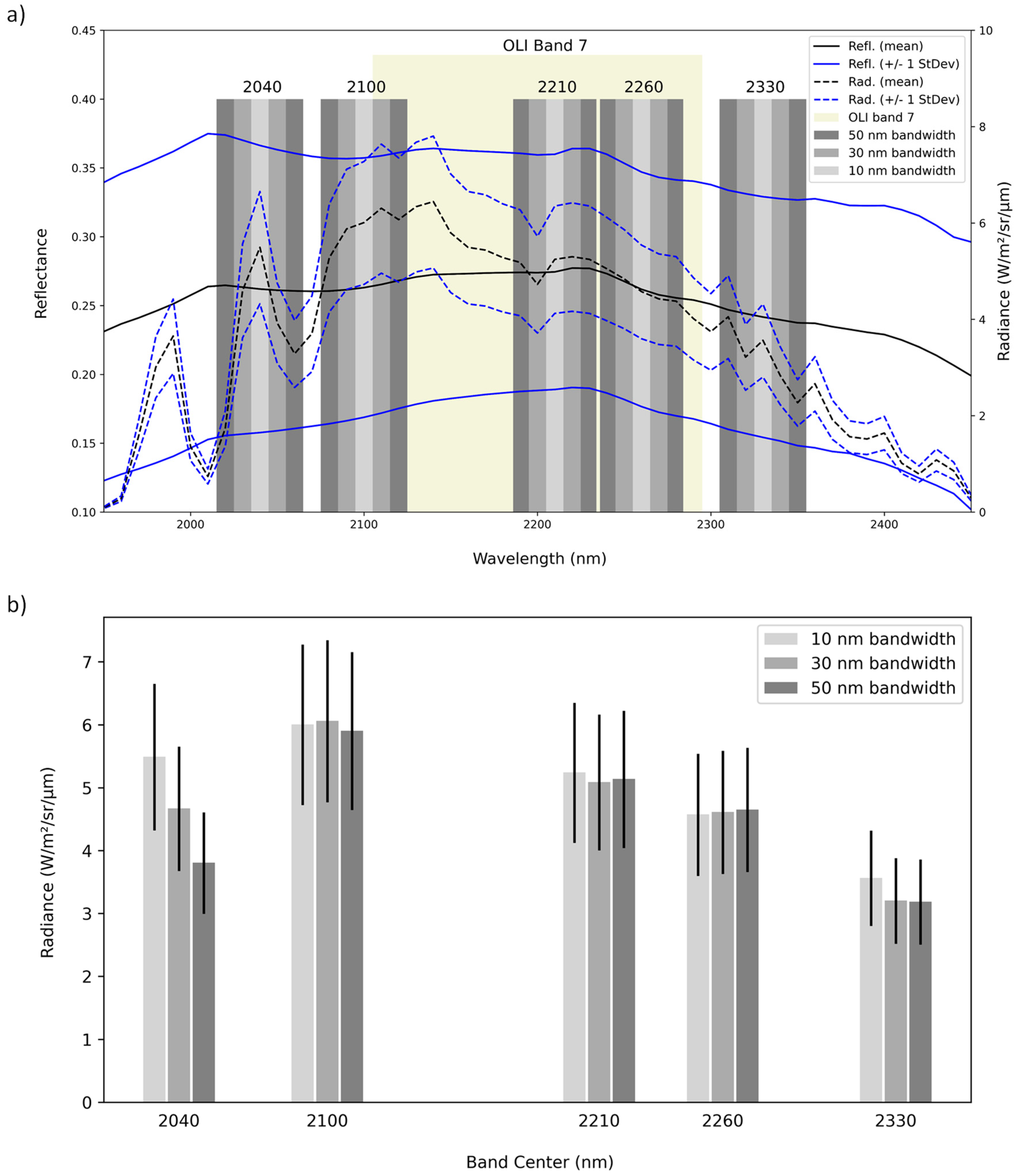
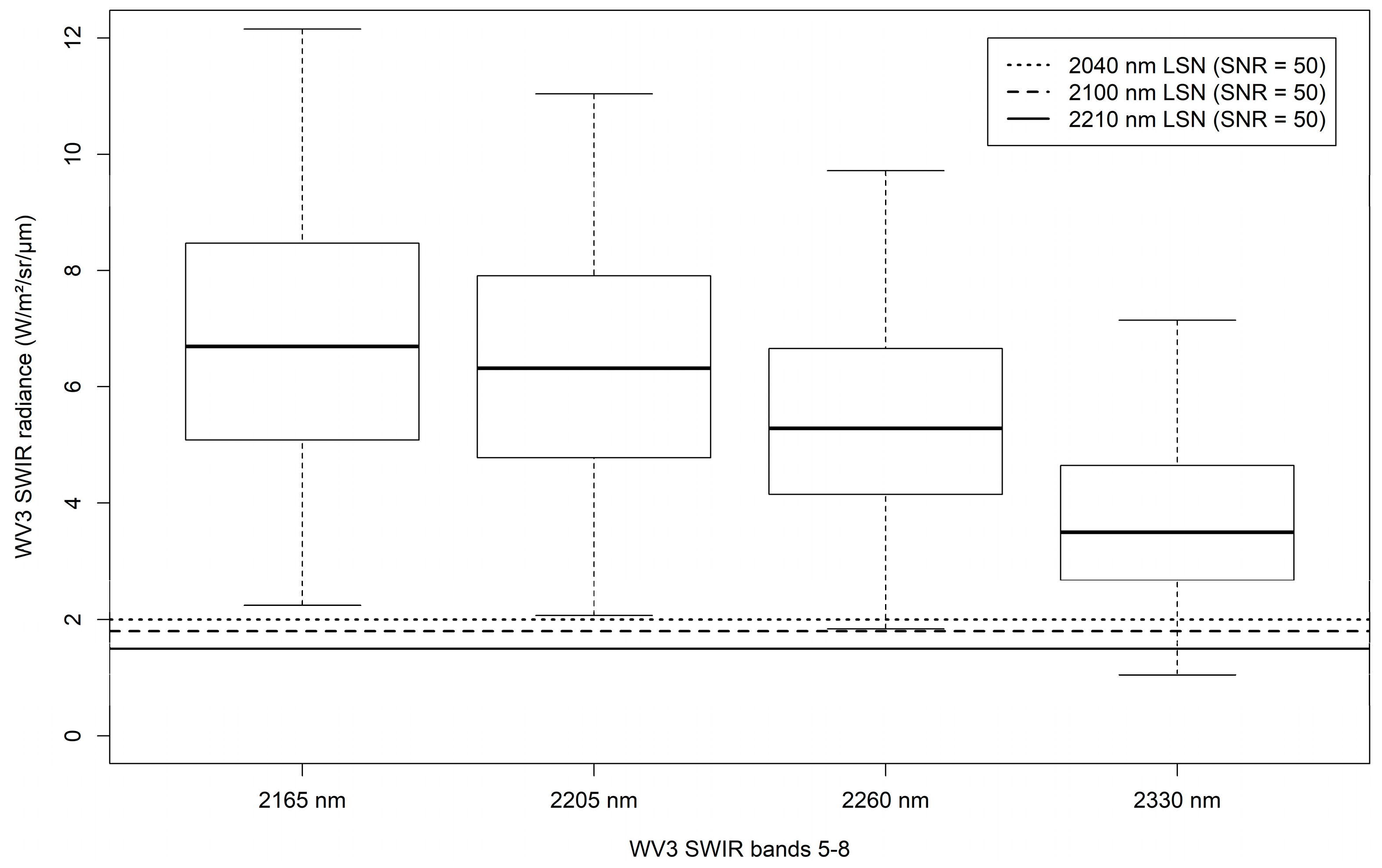
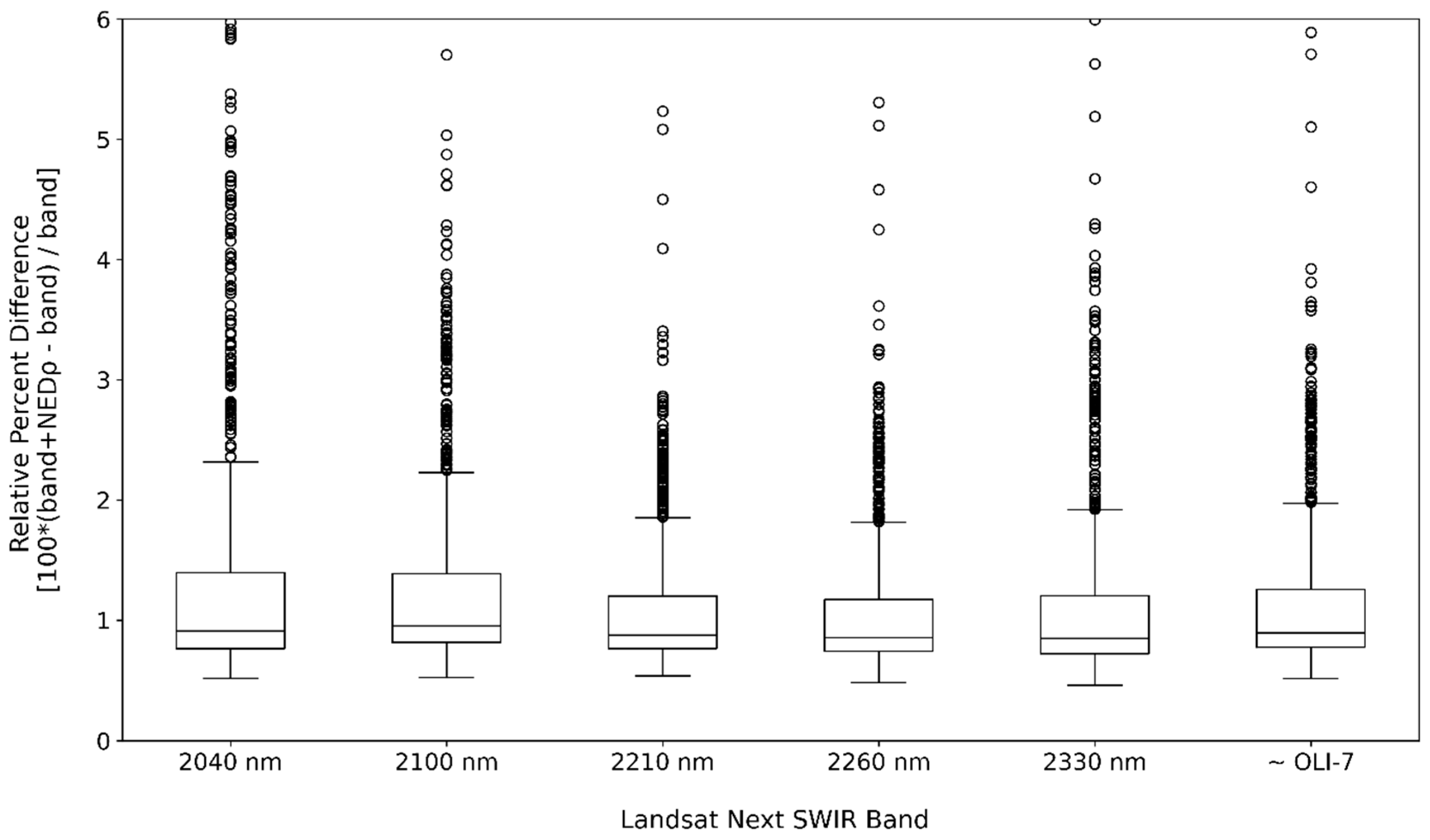
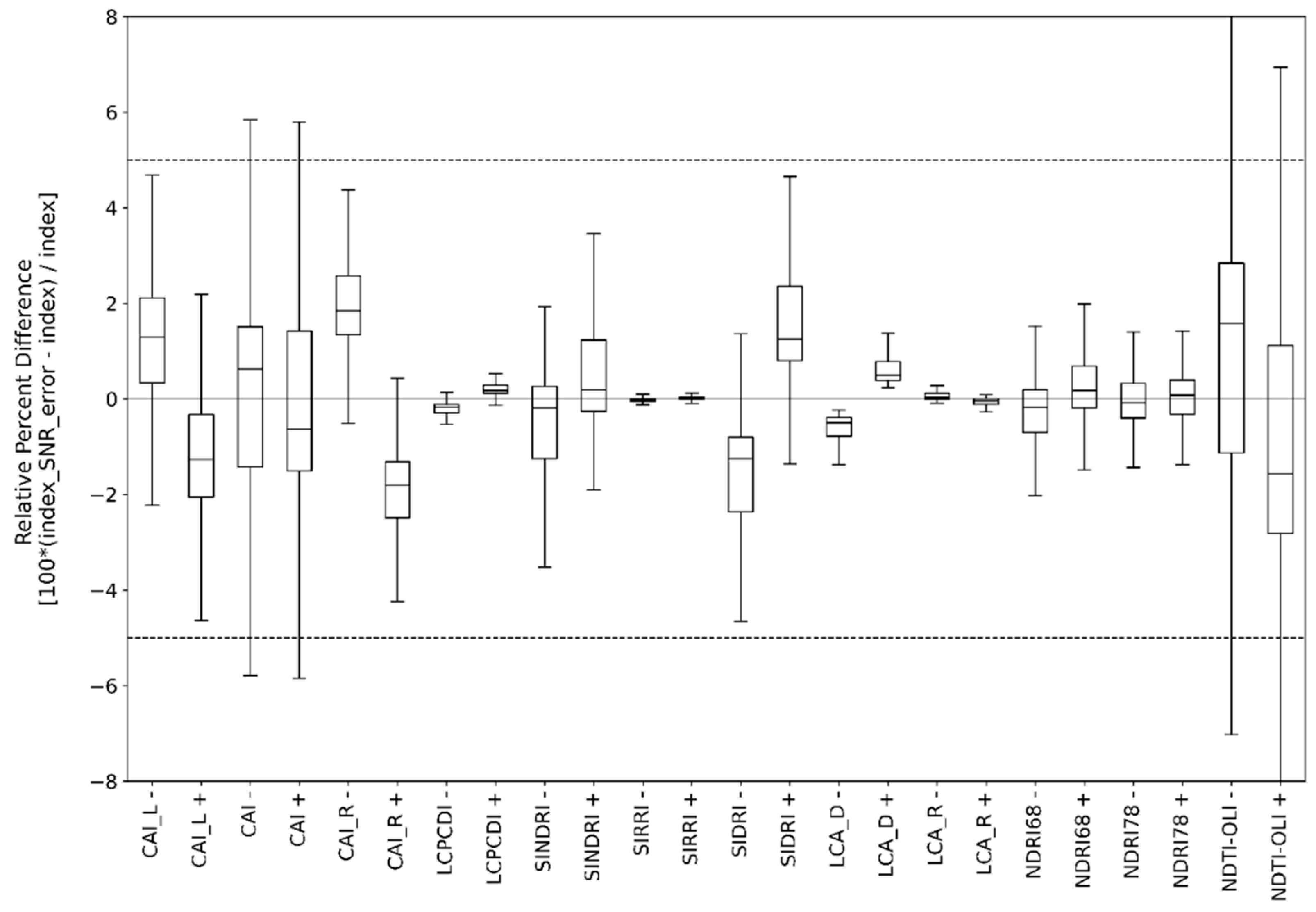

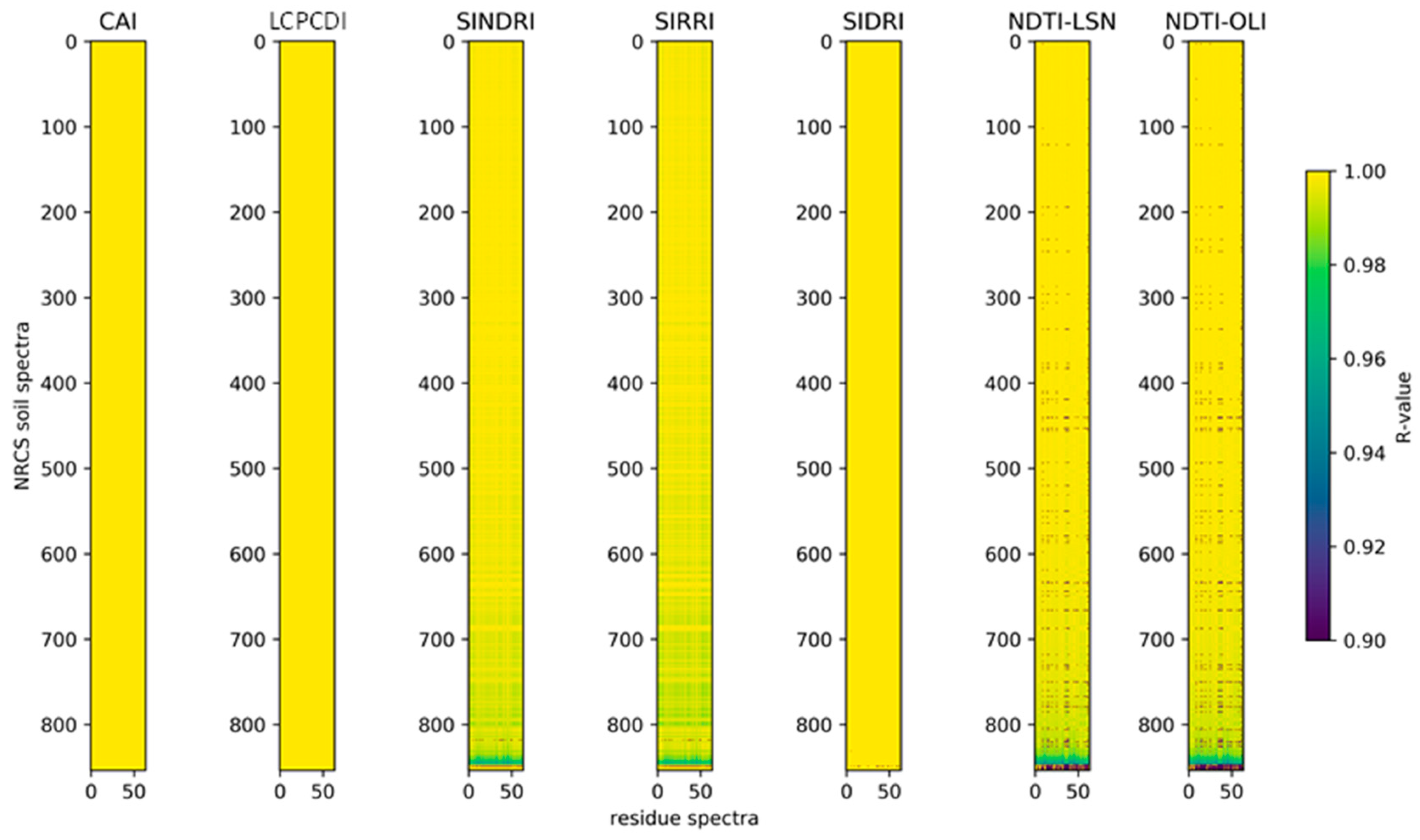
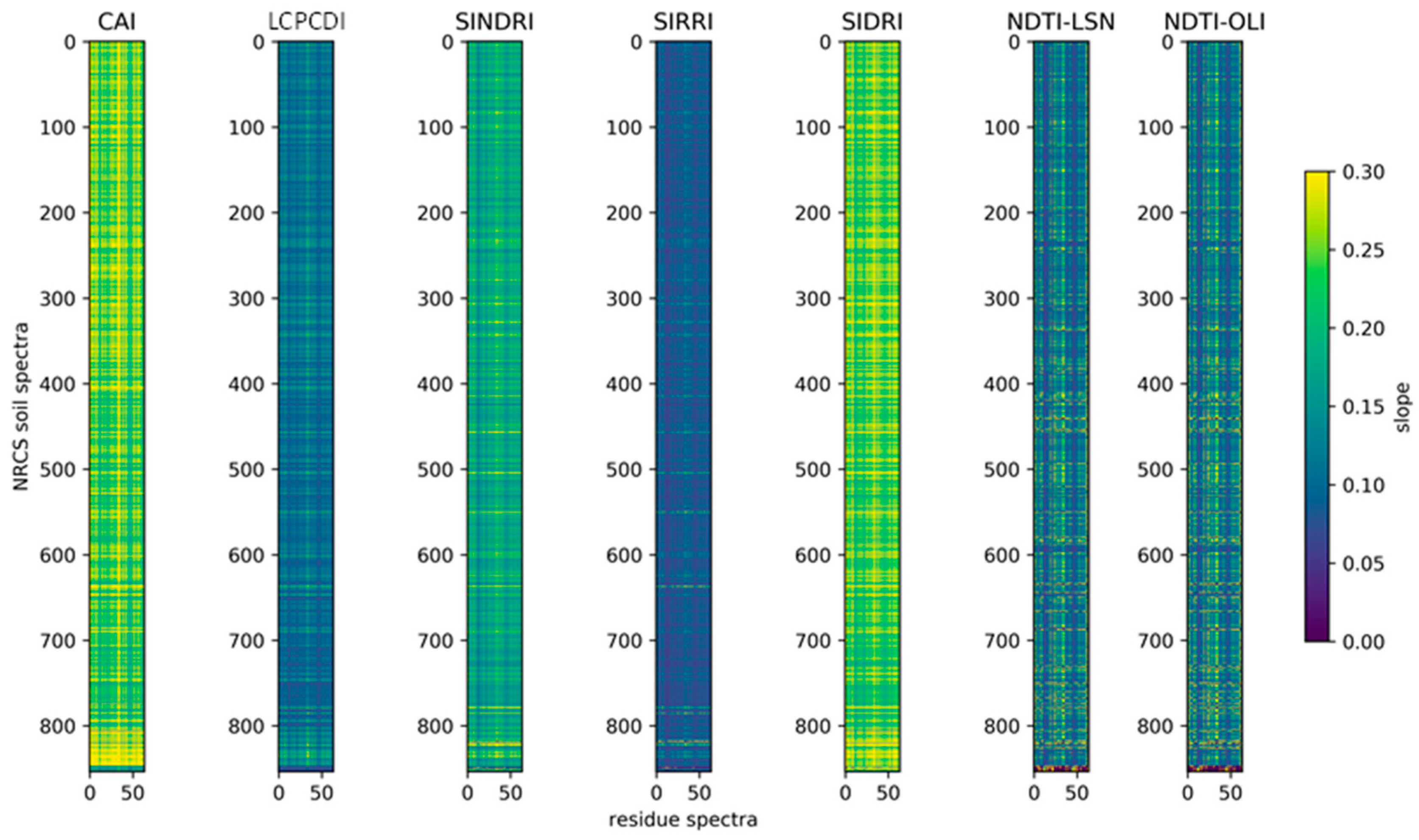
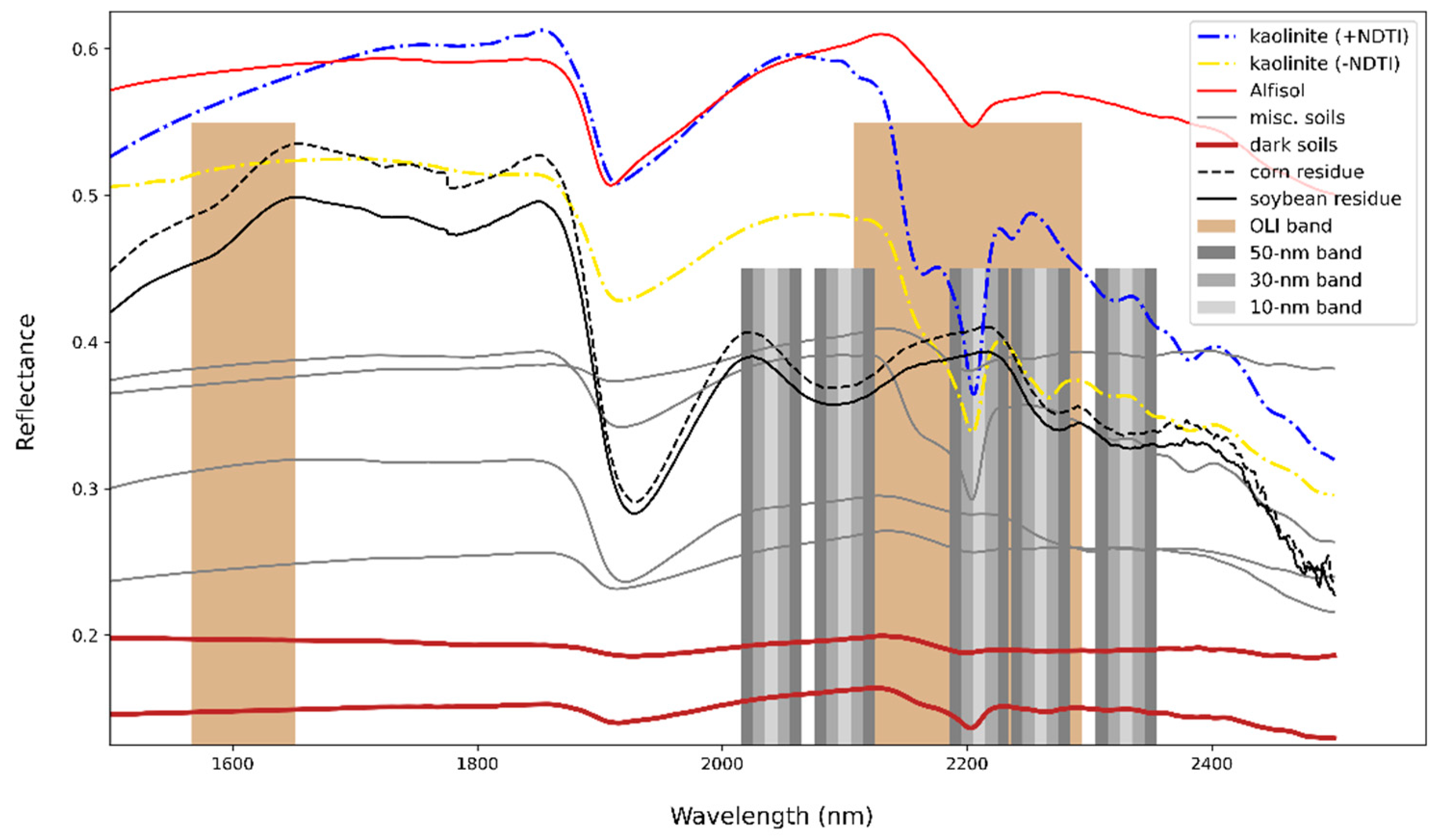
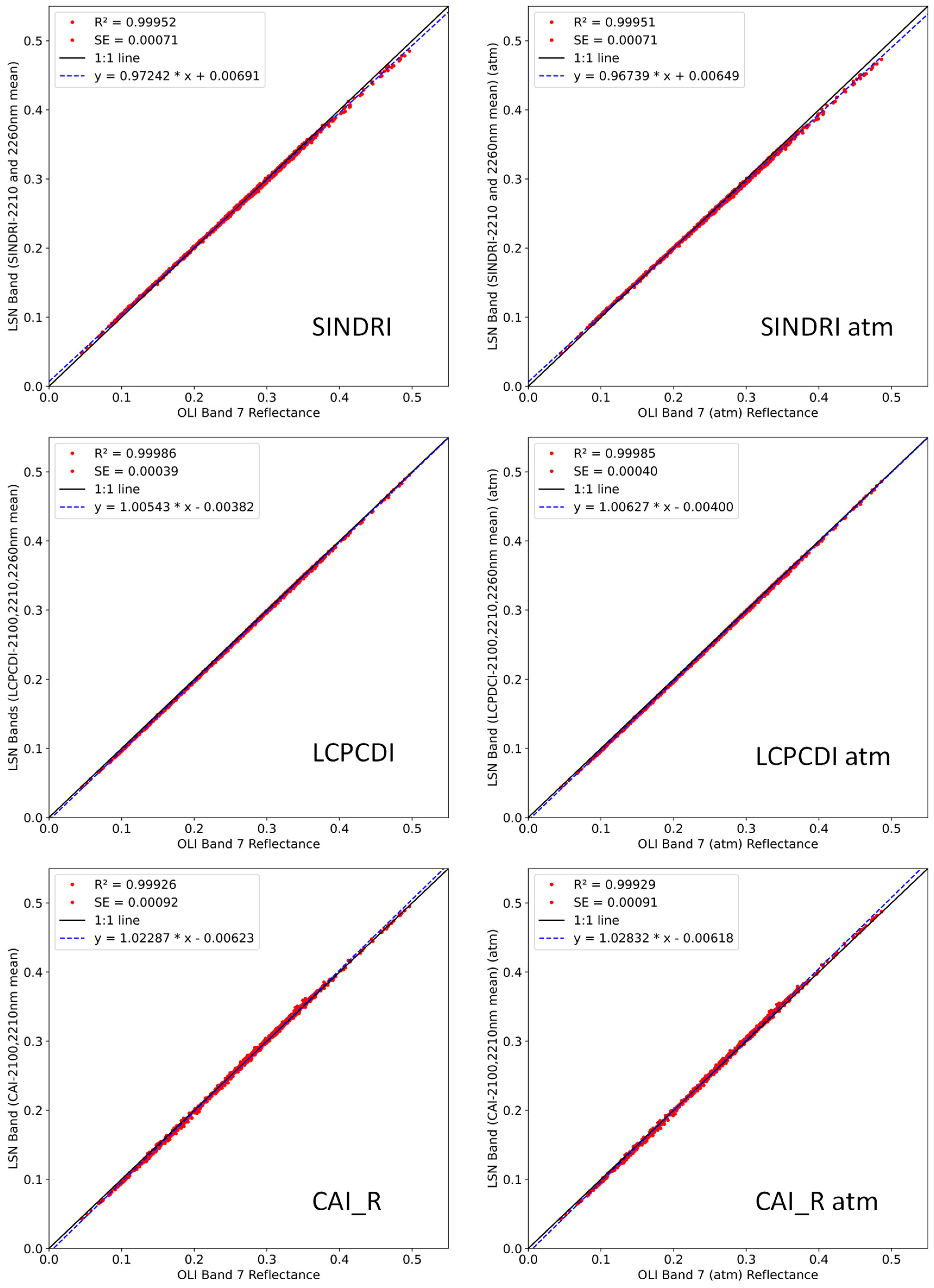
| Index | Band Center Wavelength (nm) | Equation | # Bands | Type | Citation | ||||
|---|---|---|---|---|---|---|---|---|---|
| 2040 | 2100 | 2210 | 2260 | 2330 | |||||
| CAI_L | x | x | (2040 − 2100)/(2040 + 2100) | 2 | normalized difference | new | |||
| CAI | x | x | x | 100 * (0.5 *(2040 + 2210) − 2100) | 3 | difference | [20] | ||
| CAI_R | x | x | (2210 − 2100)/(2210 + 2100) | 2 | normalized difference | new | |||
| LCPCDI | x | x | x | (2 * 2210) − (2100 + 2260) | 3 | difference | new | ||
| SINDRI | x | x | (2210 − 2260)/(2210 + 2260) | 2 | normalized difference | [10] | |||
| SIRRI | x | x | (2210/2260) | 2 | ratio | new | |||
| SIDRI | x | x | (2210 − 2260) | 2 | difference | new | |||
| LCA_D | x | x | x | (2 * 2210) − (2100 + 2330) | 3 | difference | [9] | ||
| LCA_R | x | x | x | (2 * 2210)/(2100 + 2330) | 3 | ratio | [11] | ||
| NDRI68 | x | x | (2210 − 2330)/(2210 + 2330) | 2 | normalized difference | new | |||
| NDRI78 | x | x | (2260 − 2330)/(2260 + 2330) | 2 | normalized difference | new | |||
| NDTI-OLI * | -x- | (1609 − 2201)/(1609 + 2201) | 2 | normalized difference | [25] | ||||
| NDTI-LSN ** | -x- | (1609 − ((2100 + 2210 + 2260)/3))/(1609 − ((2100 + 2210 + 2260)/3)) | 4 | normalized difference | - | ||||
| R2 | ||||||||
| NPV | NDVI | GV | Soil | |||||
| Index | NDVI < 0.3 | NDVI < 1.0 | NDVI < 0.3 | NDVI < 1.0 | NDVI < 0.3 | NDVI < 1.0 | NDVI < 0.3 | NDVI < 1.0 |
| SINDRI | 0.81 | 0.40 | 0.28 | 0.16 | 0.02 | 0.10 | 0.78 | 0.77 |
| SIRRI | 0.81 | 0.39 | 0.27 | 0.16 | 0.02 | 0.10 | 0.78 | 0.77 |
| SIDRI | 0.77 | 0.70 | 0.21 | 0.00 | 0.03 | 0.01 | 0.73 | 0.52 |
| CAI | 0.77 | 0.71 | 0.19 | 0.00 | 0.05 | 0.02 | 0.71 | 0.49 |
| LCA_D | 0.76 | 0.46 | 0.35 | 0.10 | 0.01 | 0.04 | 0.74 | 0.68 |
| LCPCDI | 0.75 | 0.49 | 0.35 | 0.08 | 0.02 | 0.02 | 0.72 | 0.66 |
| NDRI68 | 0.69 | 0.03 | 0.38 | 0.61 | 0.00 | 0.54 | 0.68 | 0.58 |
| LCA_R | 0.63 | 0.00 | 0.41 | 0.67 | 0.00 | 0.61 | 0.62 | 0.49 |
| CAI_R | 0.51 | 0.00 | 0.43 | 0.66 | 0.00 | 0.58 | 0.50 | 0.44 |
| NDTI_OLI | 0.44 | 0.01 | 0.40 | 0.85 | 0.00 | 0.70 | 0.45 | 0.36 |
| CAI_L | 0.40 | 0.40 | 0.00 | 0.56 | 0.05 | 0.60 | 0.36 | 0.00 |
| NDTI_LSN | 0.29 | 0.01 | 0.21 | 0.65 | 0.01 | 0.65 | 0.31 | 0.32 |
| NDRI78 | 0.24 | 0.02 | 0.30 | 0.75 | 0.02 | 0.71 | 0.27 | 0.30 |
| RMSE | ||||||||
| NPV | NDVI | GV | Soil | |||||
| Index | NDVI < 0.3 | NDVI < 1.0 | NDVI < 0.3 | NDVI < 1.0 | NDVI < 0.3 | NDVI < 1.0 | NDVI < 0.3 | NDVI < 1.0 |
| SINDRI | 0.13 | 0.24 | 0.03 | 0.17 | 0.05 | 0.25 | 0.14 | 0.16 |
| SIRRI | 0.13 | 0.25 | 0.03 | 0.17 | 0.05 | 0.25 | 0.14 | 0.16 |
| SIDRI | 0.15 | 0.17 | 0.03 | 0.19 | 0.05 | 0.27 | 0.16 | 0.22 |
| CAI | 0.15 | 0.17 | 0.03 | 0.19 | 0.05 | 0.26 | 0.16 | 0.23 |
| LCA_D | 0.15 | 0.23 | 0.03 | 0.18 | 0.05 | 0.26 | 0.15 | 0.18 |
| LCPCDI | 0.15 | 0.22 | 0.03 | 0.18 | 0.05 | 0.26 | 0.16 | 0.19 |
| NDRI68 | 0.17 | 0.31 | 0.03 | 0.12 | 0.05 | 0.18 | 0.17 | 0.21 |
| LCA_R | 0.19 | 0.31 | 0.03 | 0.11 | 0.05 | 0.17 | 0.19 | 0.23 |
| CAI_R | 0.21 | 0.31 | 0.03 | 0.11 | 0.05 | 0.17 | 0.22 | 0.24 |
| NDTI_OLI | 0.23 | 0.31 | 0.03 | 0.07 | 0.05 | 0.15 | 0.23 | 0.26 |
| CAI_L | 0.24 | 0.24 | 0.04 | 0.13 | 0.05 | 0.17 | 0.24 | 0.32 |
| NDTI_LSN | 0.26 | 0.31 | 0.03 | 0.11 | 0.05 | 0.16 | 0.25 | 0.27 |
| NDRI78 | 0.27 | 0.31 | 0.03 | 0.10 | 0.05 | 0.15 | 0.26 | 0.27 |
| Surface Reflectance | With Atmospheric Residuals | |||||||
|---|---|---|---|---|---|---|---|---|
| NDVI < 0.3 | NDVI < 1.0 | NDVI < 0.3 | NDVI < 1.0 | |||||
| Index | R2 | RMSE | R2 | RMSE | R2 | RMSE | R2 | RMSE |
| SINDRI | 0.78 | 0.14 | 0.39 | 0.25 | 0.77 | 0.15 | 0.36 | 0.25 |
| SIRRI | 0.78 | 0.14 | 0.38 | 0.25 | 0.77 | 0.15 | 0.35 | 0.25 |
| CAI | 0.75 | 0.15 | 0.68 | 0.18 | 0.76 | 0.15 | 0.60 | 0.20 |
| SIDRI | 0.74 | 0.16 | 0.67 | 0.18 | 0.72 | 0.16 | 0.67 | 0.18 |
| LCA_D | 0.73 | 0.16 | 0.44 | 0.24 | 0.73 | 0.16 | 0.46 | 0.23 |
| LCPCDI | 0.69 | 0.17 | 0.06 | 0.31 | 0.68 | 0.17 | 0.06 | 0.31 |
| NDRI68 | 0.67 | 0.18 | 0.03 | 0.31 | 0.66 | 0.18 | 0.03 | 0.31 |
| LCA_R | 0.61 | 0.19 | 0.00 | 0.31 | 0.60 | 0.19 | 0.00 | 0.31 |
| CAI_R | 0.50 | 0.22 | 0.00 | 0.31 | 0.49 | 0.22 | 0.00 | 0.31 |
| NDTI_OLI | 0.42 | 0.23 | 0.01 | 0.31 | 0.42 | 0.23 | 0.01 | 0.31 |
| NDTI_LSN | 0.41 | 0.24 | 0.01 | 0.31 | 0.41 | 0.24 | 0.01 | 0.31 |
| CAI_L | 0.38 | 0.24 | 0.37 | 0.25 | 0.36 | 0.24 | 0.37 | 0.25 |
| NDRI78 | 0.21 | 0.27 | 0.02 | 0.31 | 0.20 | 0.27 | 0.02 | 0.31 |
Publisher’s Note: MDPI stays neutral with regard to jurisdictional claims in published maps and institutional affiliations. |
© 2021 by the authors. Licensee MDPI, Basel, Switzerland. This article is an open access article distributed under the terms and conditions of the Creative Commons Attribution (CC BY) license (https://creativecommons.org/licenses/by/4.0/).
Share and Cite
Hively, W.D.; Lamb, B.T.; Daughtry, C.S.T.; Serbin, G.; Dennison, P.; Kokaly, R.F.; Wu, Z.; Masek, J.G. Evaluation of SWIR Crop Residue Bands for the Landsat Next Mission. Remote Sens. 2021, 13, 3718. https://doi.org/10.3390/rs13183718
Hively WD, Lamb BT, Daughtry CST, Serbin G, Dennison P, Kokaly RF, Wu Z, Masek JG. Evaluation of SWIR Crop Residue Bands for the Landsat Next Mission. Remote Sensing. 2021; 13(18):3718. https://doi.org/10.3390/rs13183718
Chicago/Turabian StyleHively, Wells Dean, Brian T. Lamb, Craig S. T. Daughtry, Guy Serbin, Philip Dennison, Raymond F. Kokaly, Zhuoting Wu, and Jeffery G. Masek. 2021. "Evaluation of SWIR Crop Residue Bands for the Landsat Next Mission" Remote Sensing 13, no. 18: 3718. https://doi.org/10.3390/rs13183718
APA StyleHively, W. D., Lamb, B. T., Daughtry, C. S. T., Serbin, G., Dennison, P., Kokaly, R. F., Wu, Z., & Masek, J. G. (2021). Evaluation of SWIR Crop Residue Bands for the Landsat Next Mission. Remote Sensing, 13(18), 3718. https://doi.org/10.3390/rs13183718







